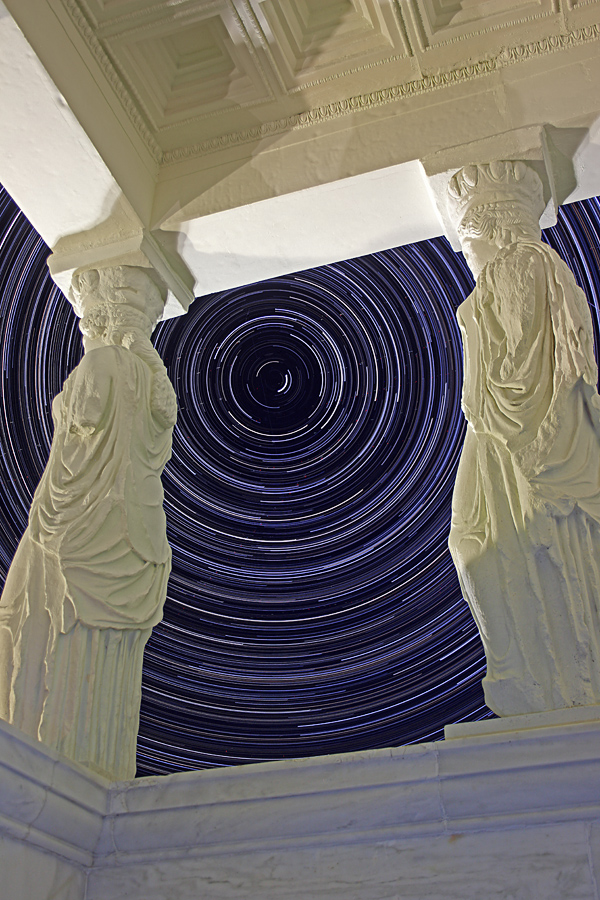
One of the most basic types of astrophotography and yet equally stunning is that involving star trails, particularly
around the celestial poles or immediately due east or west. In addition to capturing the motion of stars around the
north pole which are circumpolar and, hence, never rise or set, we also have the ability to capture seasonal
constellations and stars in such photos, thus allowing for different opportunities during different seasons. Star trail
photos also provide direct evidence that our planet rotates and does so at a rate of 15° per hour. Furthermore, by
studying the arc for a particular star, especially as far away from the pole as possible, one can indirectly estimate
the length of the (total) exposure which often ranges from seven to eight hours in duration and is totally dependent
on the end of astronomical twilight one evening and its onset
the following morning.
Many star photos are centered on Polaris, a double star system which represents our quickest means to locating the
north celestial pole, for it lies less than 1.0° from it, and is an excellent starting point for the polar alignment
of a telescope (and finding your way home if you are lost!). Due to the extended length of the typical exposures
involved, the best film for such work is Kodak Elite Chrome (ISO 100) whose reciprocity failure is nearly zero or
Fujichrome Velvia and Provia (ISO 50 and 100) emulsions with equally impressive curves! With respect to equipment, it
is rudimentary, for a camera with extended exposure capability is required along with a firm tripod and shutter
release and locking cable. It is also preferable that the camera used have a mechanical shutter so that battery
consumption and power does not become an issue during mid-exposure. The final requirement is a location with dark
skies - the darker the better so that the trails and their colouration will be as bright and contrasty as possible -
with, preferably, an interesting foreground which can be used to enrich the final result.
Note: One of the most stunning and well-recognized monuments associated with the Golden Age
of Ancient Greece is the Erechtheion atop the Acropolis and which was constructed between 421 and 406 BC. Measuring over
8.0 meters in height, 20.0 meters in length and 11.2 meters in width, its southern compartment is comprised of six maidens
(known as karyatides) whose head and torso not only grace the sides of the rectangular marble structure but whose heads
also support its roof. The marble maidens are approximately 2.36 meters in height, dressed in ancient chiton (ionic style)
which extends down to their ankles and with richly interwoven hair reaching their back.
Karyatides are literally the virgin maidens from the small town of Karyes approximately two hours southwest of Athens
and who were best known for their dances during annual celebrations in honour of the Goddess Artemis. Nearly 2500 years
later, the residents of Karyes decided to reconstruct a faithful replica of the Erechtheion (in 1983) for display in their
town as a reminder of the historical connection between the Erechtheion in Athens and their maidens from well over two millenia ago.
Note: For additional results with notable foregrounds from around the world involving the overhead
sky during the day and/or night, please click here.
|
Proper Star Name: Polaris Bayer Letter: á Ursae Minoris Tycho Catalog: TYC 4628-237-1 SAO Catalog: SAO 308 Luminosity 2290 +/- 282 x Sun Distance: 431 +/- 26 light yrs RA / Dec: 02h 39m 31s / +89° 17' 39" B-V Color Index: +0.570 mag Magnitude: 1.98 |
 |
Date: July 04-05, 2019 22:47 - 04:47 UT+3 Location: Karyes, Laconia, Greece Equipment: Canon EOS 700D Canon EOS EF-S 18-55 mm @ 18 mm / f8.0 Exposures: 360 min (690 x 30 sec) (RGB) 005 min (010 x 30 sec) (Dark) ISO 400 JPG Fine Image Format 5184x3456 Image Size Auto White Balance Manual Mode Continuous Servo Mode Software: Sequator V1.4 Photoshop CS5 Processing: Dark Frame Reduction Layers and Lighten Resampling Unsharp Masking JPG Compression |